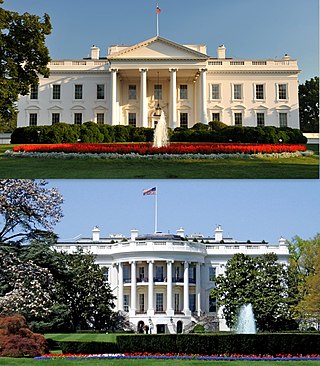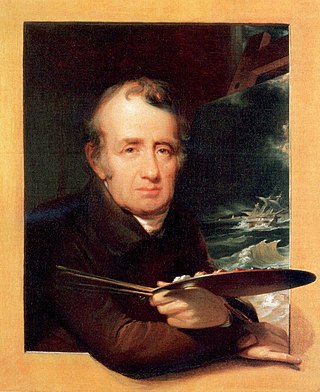
Thomas Mifflin was an American merchant, soldier, and politician from Pennsylvania, who is regarded as a Founding Father of the United States for his roles during and after the American Revolution. Mifflin signed the United States Constitution, was the first governor of Pennsylvania, serving from 1790 to 1799, and was also the state's last president, succeeding Benjamin Franklin in 1788.

The White House is the official residence and workplace of the president of the United States. Located at 1600 Pennsylvania Avenue NW in Washington, D.C., it has served as the residence of every U.S. president since John Adams in 1800 when the national capital was moved from Philadelphia. The term "White House" is often used as metonymy for the president and his advisers.

Robert Morris Jr. was an English-American merchant and a Founding Father of the United States. He served as a member of the Pennsylvania legislature, the Second Continental Congress, and the United States Senate, and he was a signer of the Declaration of Independence, the Articles of Confederation, and the United States Constitution. From 1781 to 1784, he served as the Superintendent of Finance of the United States, becoming known as the "Financier of the Revolution." Along with Alexander Hamilton and Albert Gallatin, he is widely regarded as one of the founders of the financial system of the United States.

William Bingham was an American statesman from Philadelphia. He was a delegate for Pennsylvania to the Continental Congress from 1786 to 1788 and served in the United States Senate from 1795 to 1801. Bingham was one of the wealthiest men in the United States during his lifetime, and was considered to be the richest person in the U.S. in 1780.
The Philomathean Society of the University of Pennsylvania is a collegiate literary society, the oldest student group at the university, and a claimant to the title of the oldest continuously-existing literary society in the United States, a claim disputed by Columbia University's Philolexian Society, which was established in 1802. Founded in 1813, its goal is "to promote the learning of its members and to increase the academic prestige of the University." Philomathean is derived from the Greek philomath, which means "a lover of learning." The motto of the Philomathean Society is Sic itur ad astra.

The Residence Act of 1790, officially titled An Act for establishing the temporary and permanent seat of the Government of the United States, is a United States federal statute adopted during the second session of the 1st United States Congress and signed into law by President George Washington on July 16, 1790. The Act provides for a national capital and permanent seat of government to be established at a site along the Potomac River and empowered President Washington to appoint commissioners to oversee the project. It also set a deadline of December 1800 for the capital to be ready, and designated Philadelphia as the nation's temporary capital while the new seat of government was being built. At the time, the federal government operated out of New York City.

Independence National Historical Park is a federally protected historic district in Philadelphia, Pennsylvania that preserves several sites associated with the American Revolution and the nation's founding history. Administered by the National Park Service, the 55-acre (22 ha) park comprises many of Philadelphia's most-visited historic sites within the Old City and Society Hill neighborhoods. The park has been nicknamed "America's most historic square mile" because of its abundance of historic landmarks.

The Powel House is a historic house museum located at 244 South 3rd Street, between Willings Alley and Spruce Street, in the Society Hill neighborhood of Philadelphia, Pennsylvania. Built in 1765 in the Georgian style, and embellished by second owner Samuel Powel (1738–1793), it has been called "the finest Georgian row house in the city." As with other houses of this type, the exterior facade is understated and simple, but the interior was elaborately appointed.

Market Street, originally known as High Street, is a major east–west highway and street in Philadelphia, Pennsylvania, United States. The street is signed as Pennsylvania Route 3 between 38th Street and 15th Street. A short portion of the road continues west from Cobbs Creek Parkway to Delaware County, adjacent to Philadelphia. The street also serves as the dividing line for the "north" and "south" sides of the city. All north-south addresses in the city start at zero at Market Street.

Walnut Street Prison was a city jail and penitentiary house in Philadelphia, Pennsylvania, from 1790 to 1838. Legislation calling for establishment of the jail was passed in 1773 to relieve overcrowding in the High Street Jail; the first prisoners were admitted in 1776. It was located at Sixth and Walnut Streets, where it acquired its original name Walnut Street Jail.

Joseph Hemphill was an American politician who served as a Federalist member of the U.S. House of Representatives for Pennsylvania's 3rd congressional district from 1801 to 1803, as a Jackson Federalist representative for Pennsylvania's 1st congressional district from 1819 to 1823 and as a Jacksonian representative for Pennsylvania's 2nd congressional district from 1829 to 1831.

College Hall is the oldest building on the West Philadelphia campus of the University of Pennsylvania. Prior to its construction, the university was located on Ninth Street in Center City, Philadelphia. The building was designed by Thomas Webb Richards and completed in 1873. The characteristic green color of the building is due to its composition of green serpentine stone.

Thomas Birch was an English-born American portrait and marine painter.

Sweetbriar is a Neoclassical mansion in the Federal style built in 1797 in West Fairmount Park, Philadelphia. The mansion was built by Samuel Breck and named for the roses that grew on the property. The interior includes a double parlor and floor-to-ceiling windows with sweeping views of the Schuylkill River. Period pieces include Chinese armorial porcelain, Hepplewhite and Sheraton style chairs, and Adam style furniture. Wedgwood jasperware and fireplaces with delicate plaster decorations were influenced by discoveries in the ancient houses of Pompeii. Bird prints by John James Audubon and paintings by William Birch decorate the walls.

The President's House in Philadelphia was the third U.S. Presidential Mansion. George Washington occupied it from November 27, 1790, to March 10, 1797, and John Adams occupied it from March 21, 1797, to May 30, 1800.
Events from the year 1800 in the United States.
The Philadelphia Aurora was a newspaper, published six days a week in Philadelphia from 1794 to 1824. The paper was founded by Benjamin Franklin Bache, and was continued as a tri-weekly, after his death from yellow fever in September 1798, as a leading organ of radical republicanism by the Irish-American journalist William Duane.

The Alexander Macomb House at 39–41 Broadway in Lower Manhattan, New York City, served as the second U.S. Presidential Mansion. President George Washington occupied it from February 23 to August 30, 1790, during New York City's two-year term as the national capital. The building was demolished in 1940, the last former U.S. presidential mansion to be demolished.

The Government House was a Georgian-style mansion at the foot of Broadway, south of Bowling Green, on the site previously occupied by Fort George in Manhattan, New York City. Built in 1790 by the state of New York, it was intended to be the executive mansion for President George Washington, but he never occupied it. Before it was completed, the federal government moved temporarily to Philadelphia; then permanently to Washington, D.C. It then became the state governor’s residence and was used by George Clinton and John Jay. Later it was leased to John Avery and was known as the Elysian Boarding House. After the passage of the Customs Administration Act in 1799, it was converted into the Custom House in New York. Parts of the building were later leased to the American Academy of Arts, who then offered space to the New-York Historical Society in 1809. In 1813, the property was sold to the city. In 1815, the land was sold to the public and the building demolished.

Birch's Views of Philadelphia was an 1800 book of prints drawn and engraved by William Russell Birch (1755–1834) and his son Thomas Birch (1779–1851). The 27 illustrations of the city are extraordinarily valuable to historians because they document Philadelphia architecture and street-life at the beginning of the nineteenth century.


















